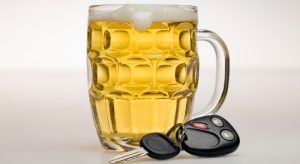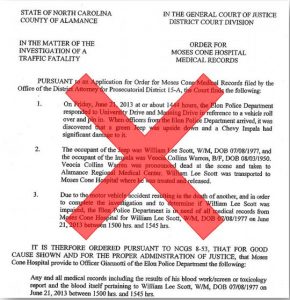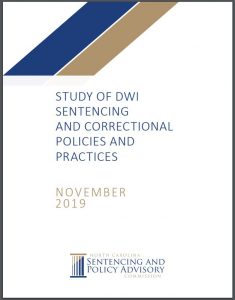When a person is convicted of driving while impaired under G.S. 20-138.1, the person’s license is revoked for one year. G.S. 20-17(a)(2); G.S. 20-19(c1). (A person who has one or more prior convictions for an offense involving impaired driving may be subject to a longer period of revocation, depending on when those offenses occurred.) At the conclusion of that one-year revocation period, the person may seek to have his or her license restored by furnishing proof of financial responsibility and by paying a restoration fee of $140.25. G.S. 20-7(c1), (i1). The license then may be restored with a restriction prohibiting the person from operating a vehicle with an alcohol concentration of 0.04 or more at any relevant time after the driving. G.S. 20-19(c3). That restriction, listed on the driver’s license as Restriction 19, remains in effect for three years. This post addresses how such a restriction is enforced and the consequences for a substantiated violation.
DWI
State v. Rouse and Circumstantial Evidence of Driving
To prove impaired driving, the State must establish that the defendant drove a vehicle while impaired. A person drives when he or she is “actual physical control of a vehicle which is in motion or which has the engine running.” G.S. 20-4.01(25). Sometimes the State may establish driving through direct evidence. For example, a law enforcement officer or another witness may observe the defendant driving and may testify to that fact. In other cases, a law enforcement officer may encounter the person the officer believes was driving after the driving has concluded, perhaps in or near the car or at some other location. In those cases, the State may seek to establish driving based on circumstantial evidence. The Court of Appeals’ recent opinion in State v. Rouse, 2022-NCCOA-496, __ N.C. App. ___ (July 19, 2022), considers when such circumstantial evidence is sufficient to survive a motion to dismiss.
2021 Statistical Report for Driving While Impaired Convictions Now Available
Last week, Jamie blogged about the 2021 Structured Sentencing Statistical Report from the North Carolina Sentencing and Policy Advisory Commission. As Jamie noted, that report contains detailed information related to felony and misdemeanor sentences imposed in Fiscal Year 2021, including the most commonly used felony grid cell, the number of convictions by district, average probation length, and typical sentencing outcomes for the most charged offenses. Because that report analyzes felony and misdemeanor convictions and sentences imposed under the Structured Sentencing Act, it does not include information about one of the most commonly charged misdemeanors in North Carolina: driving while impaired, which is sentenced under the sentencing scheme set out in G.S. 20-179. The Sentencing and Policy Advisory Commission prepares a separate report each year analyzing those convictions, and the Driving While Impaired Convictions Statistical Report for Fiscal Year 2021 is available here. Read on for highlights from the report, which contains data about convictions under G.S. 20-179 from July 1, 2020 through June 30, 2021.
Enforcing Ignition Interlock Requirements
I wrote last week about changes to North Carolina’s ignition interlock statutes that were effective June 1, 2022. As I noted in that post, one of those changes was to eliminate the time and purpose restrictions that otherwise apply to limited driving privileges if ignition interlock is required as a condition and the person is driving a designated vehicle equipped with ignition interlock. Another was to require vendors to waive a portion of ignition interlock costs for a person ordered by a court or required by statute to install ignition interlock but who is unable to afford the system. These changes and others enacted by S.L. 2021-82 were recommended by the Ignition Interlock Subcommittee of the Statewide Impaired Driving Task Force as part of a package of reforms designed to expand the use of ignition interlock and, in turn, to improve traffic safety. It remains to be seen whether the legislation will have that effect.
One determinant may be whether drivers see the benefit of broader driving privileges as being worth the cost of ignition interlock. A judge may be more likely to impose the condition when it is sought by an applicant. Another factor may be whether judges believe that ignition interlock is an effective countermeasure to impaired driving (researchers in fact identify interlock as among the leading countermeasures) and whether ignition interlock requirements in limited driving privileges are enforced in practice. This post addresses this last issue by reviewing the mechanisms for enforcing ignition interlock requirements and the sanctions for violation of ignition interlock conditions imposed by a court as part of a limited driving privilege.
Applying the Statute of Limitations to Failure to Appear for an Implied Consent Offense
Nearly 15 years ago, the General Assembly created the misdemeanor offense of failing to appear for two years for an implied consent offense. See S.L. 2006-253 (enacting new G.S. 20-28(a3), effective for offenses committed on or after December 1, 2006). The new provision was proposed by the Governor’s Task Force on Driving While Impaired in order to impose special sanctions for a person who fails to appear in court for this particular kind of motor vehicle offense. Those sanctions include driver’s license revocation for a person convicted of a violation of G.S. 20-28(a3)(2).
In the early years after the statute was enacted, there were many questions about which offenses it applied to. Offenses charged before December 1, 2004 for which the person had already failed to appear for two years before the statute’s effective date? Arguably not, for ex post facto reasons, as Jeff opined here. What about offenses charged a bit later for which the defendant already had failed to appear before December 1, 2006? Perhaps not, given the presumption of prospective application, as I wrote here. More recently questions have arisen about how to calculate the two-year statute of limitations for such an offense. Suppose, for example, a defendant was charged with DWI on January 1, 2017. The defendant failed to appear in court. On June 2, 2021, the State charged the defendant with failure to appear for two years after being charged with an implied consent offense. Does the two-year statute of limitations in G.S. 15-1 bar the prosecution?
DWI Update: May 2020 Edition
My colleagues and I usually spend the waning weeks of May slogging through months of appellate opinions, determining which cases merit discussion at upcoming summer conferences. This year, of course, there are no live summer conferences. Yet we are still slogging. We are delivering a virtual criminal case update for district court judges this week … Read more
Buckling Up: Part of the Strategy to Reduce Deaths from Impaired Driving
North Carolina’s Impaired Driving Task Force held its first quarterly meeting of 2020 a few weeks ago. Bill Naff, program manager for the National Highway Traffic Safety Administration (NHTSA), spoke at the meeting about strategies to reduce impaired driving fatalities. You might be surprised to hear about one strategy that was near the top of the list: Get every vehicle occupant to buckle up. 
Obtaining Medical Records in DWI Cases
Commission Recommends Changes to DWI Laws and Correctional Policies
The North Carolina Sentencing and Policy Advisory Commission released last November a report recommending several changes to the state’s impaired driving laws and correctional policies. The report marked the culmination of more than three years of study that included examination of DWI sentencing and correctional data as well as consideration of input from law enforcement, prosecutors, defense attorneys, and providers of substance abuse treatment. The report’s fifteen recommendations address issues ranging from pretrial conditions of release for defendants charged with impaired driving to the place of confinement for defendants serving active sentences.
Straight Talk about DWI
Happy New Year, everyone.
A few months ago, I blogged about the continuing phenomenon of impaired driving, the fatalities resulting from crashes involving impaired drivers, and recommendations from experts about how to reduce the incidence of impaired driving. Some of the feedback I received indicated that talk of solutions ought to be preceded by common agreement on the nature of the problem.

